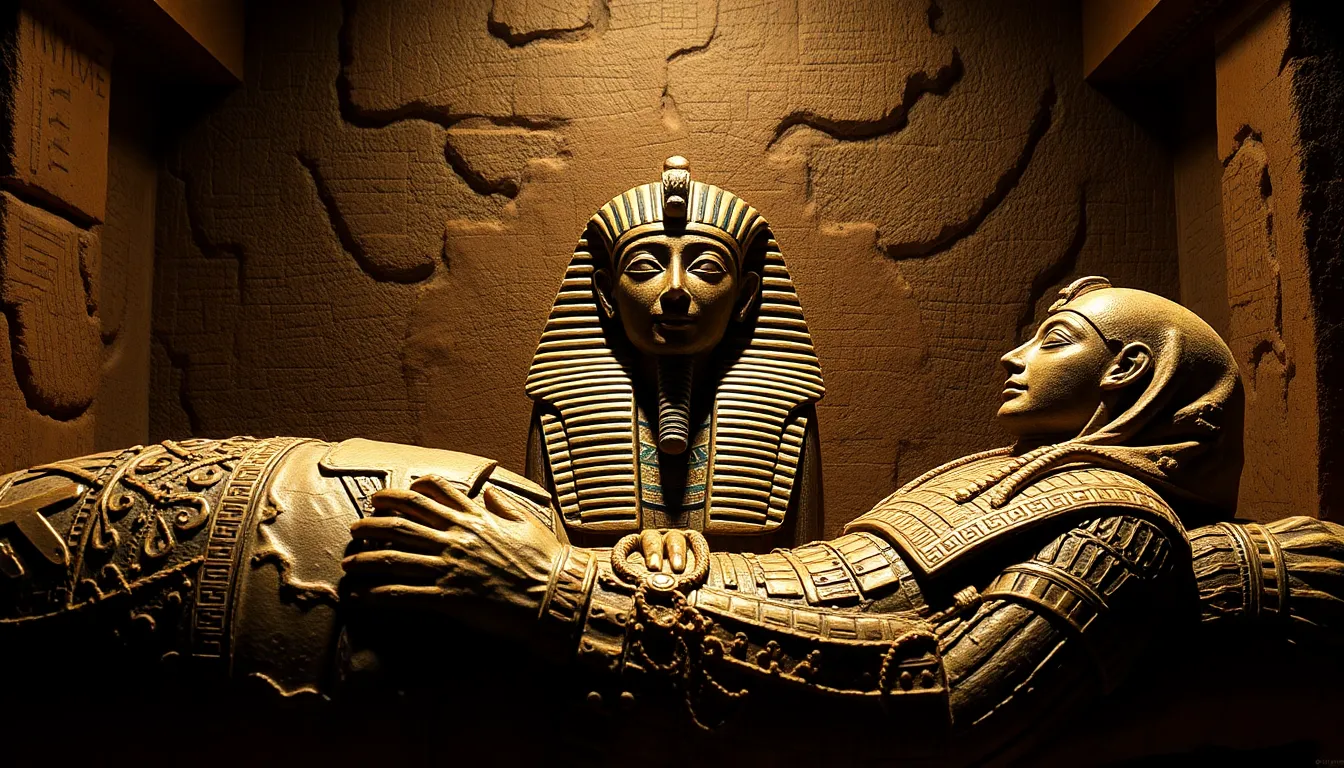The Sacred Geometry of Egyptian Mummies: The Art of Preservation
I. Introduction
Ancient Egyptian mummification practices are among the most fascinating elements of Egyptology, embodying a complex interplay of religious beliefs, cultural rituals, and artistic expression. The Egyptians believed that preserving the body was essential for a successful journey into the afterlife, where the deceased would continue to exist in a different realm. At the heart of these practices lies the concept of sacred geometry, which played a vital role in the spiritual and physical aspects of mummification.
This article aims to explore the significance of sacred geometry in the context of Egyptian mummification, examining how geometric concepts influenced the methods of preservation and the beliefs surrounding the afterlife.
II. The Significance of Mummification in Ancient Egypt
Mummification was not merely a method of preserving the physical form; it was deeply intertwined with the beliefs and practices of ancient Egyptians regarding the afterlife. Key aspects include:
- Beliefs about the afterlife: Ancient Egyptians held the belief that life continued after death. The preservation of the body was deemed crucial for the deceased to enjoy eternal life.
- Role of mummies in religious rituals: Mummies were central to various religious ceremonies, as they were thought to house the spirit or ‘ka’ of the individual. This made them sacred objects in the eyes of the living.
- The process of preserving the body for eternity: Mummification involved intricate techniques including embalming, drying, and wrapping the body, aimed at preventing decay and ensuring the body remained intact for eternity.
III. Understanding Sacred Geometry
Sacred geometry refers to geometric shapes and patterns that have spiritual significance. Historically, these shapes were believed to represent the fundamental forms of space and time. Key components include:
- Definition and historical context: Sacred geometry encompasses various shapes such as circles, triangles, and squares, each imbued with meaning and symbolism.
- Key geometric shapes and their meanings:
- Circle: Represents eternity and the cyclical nature of life.
- Triangle: Often associated with stability and the connection between the physical and spiritual worlds.
- Square: Symbolizes the material world and the four cardinal directions.
- The relationship with ancient Egyptian architecture: The pyramids and temples of ancient Egypt were designed with precise geometric proportions, reflecting the importance of these shapes in their cosmology.
IV. Geometric Patterns in Mummification Techniques
Geometry influenced various aspects of mummification, evident in the techniques and materials used. Notable examples include:
- The role of geometry in the design of coffins and sarcophagi: These were often crafted with geometric precision, employing shapes that symbolized protection and the afterlife.
- Use of symmetrical patterns in bandaging and wrapping: The mummification process included wrapping the body in linen strips with intentional symmetry, believed to enhance the spiritual journey of the deceased.
- Analysis of geometric motifs found in tomb artifacts: Many artifacts, including jewelry and amulets, featured geometric designs that held protective or symbolic meaning, reinforcing the connection between geometry and the afterlife.
V. The Influence of Sacred Geometry on Burial Practices
The design and layout of burial sites were heavily influenced by sacred geometry, reflecting the Egyptians’ understanding of the cosmos and their beliefs. Key elements include:
- The layout of tombs and pyramids: The positioning of these structures was often aligned with the stars and cardinal points, embodying a cosmic order.
- Alignment with celestial bodies and cardinal directions: Many tombs were oriented to face specific stars or the sun, believed to facilitate the transition to the afterlife.
- Symbolism of geometry in funerary texts and inscriptions: Hieroglyphs and texts inscribed in tombs often incorporated geometric symbols that conveyed messages about the afterlife and the journey of the soul.
VI. Scientific Perspectives on Preservation Techniques
Modern science has shed light on the ancient techniques of mummification, revealing the sophistication of these methods. Key points include:
- Modern understanding of the mummification process: Scientific analysis has revealed intricate details about the embalming materials and methods used by the ancient Egyptians.
- Role of chemistry and materials used in preservation: Natural resins, oils, and salts were used to dehydrate and preserve the body, showcasing an advanced understanding of chemical processes.
- Preservation of sacred geometry in modern archaeological practices: Archaeologists today continue to study the geometric patterns and designs found in tombs, helping to uncover the cultural significance of these ancient practices.
VII. The Legacy of Egyptian Sacred Geometry
The influence of sacred geometry extends beyond ancient Egypt, impacting various aspects of art and architecture throughout history:
- Impact on art and architecture throughout history: The principles of sacred geometry can be seen in various cultures, influencing the design of churches, temples, and public buildings.
- Influence on contemporary interpretations of sacred geometry: Modern artists, architects, and spiritual practitioners draw inspiration from ancient Egyptian geometry in their work.
- Ongoing research and discoveries in Egyptology: New findings continue to emerge, revealing more about the role of geometry in ancient Egyptian culture and its applications in mummification.
VIII. Conclusion
The exploration of sacred geometry within the context of mummification highlights its profound significance in ancient Egyptian culture. The meticulous methods of preserving the body, intertwined with geometric principles, underscore the Egyptians’ belief in the afterlife and the importance of maintaining a connection between the physical and spiritual realms. As we continue to study these ancient practices, we gain deeper insights into the complexities of their beliefs and the enduring legacy of their sacred geometry.
As we reflect on the fascinating interplay between geometry and cultural preservation, we are encouraged to delve deeper into the connections that exist between ancient practices and modern interpretations, enhancing our understanding of humanity’s rich historical tapestry.




